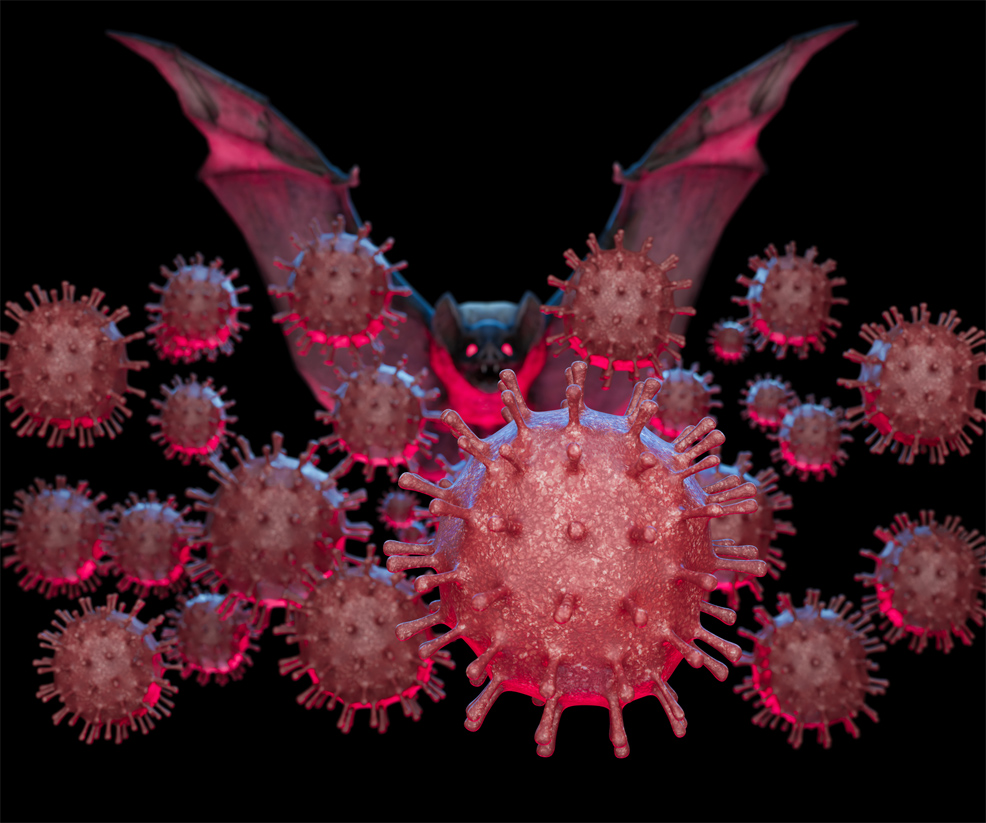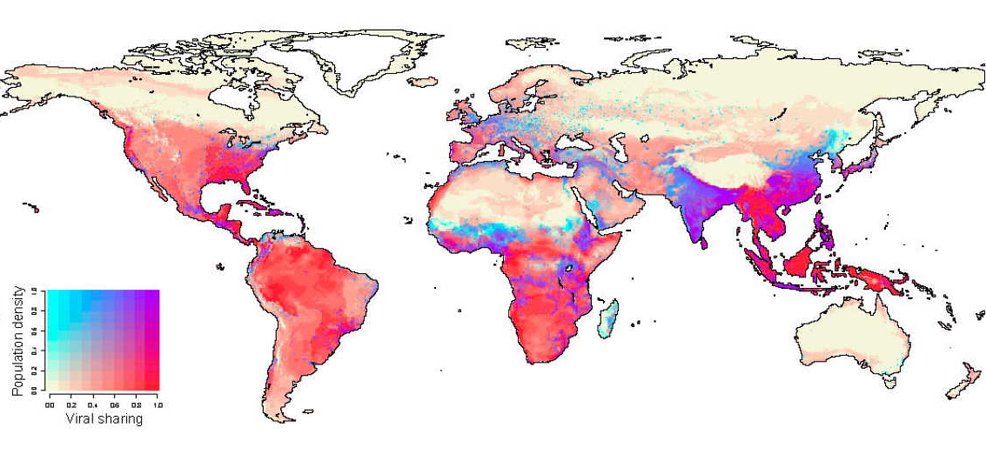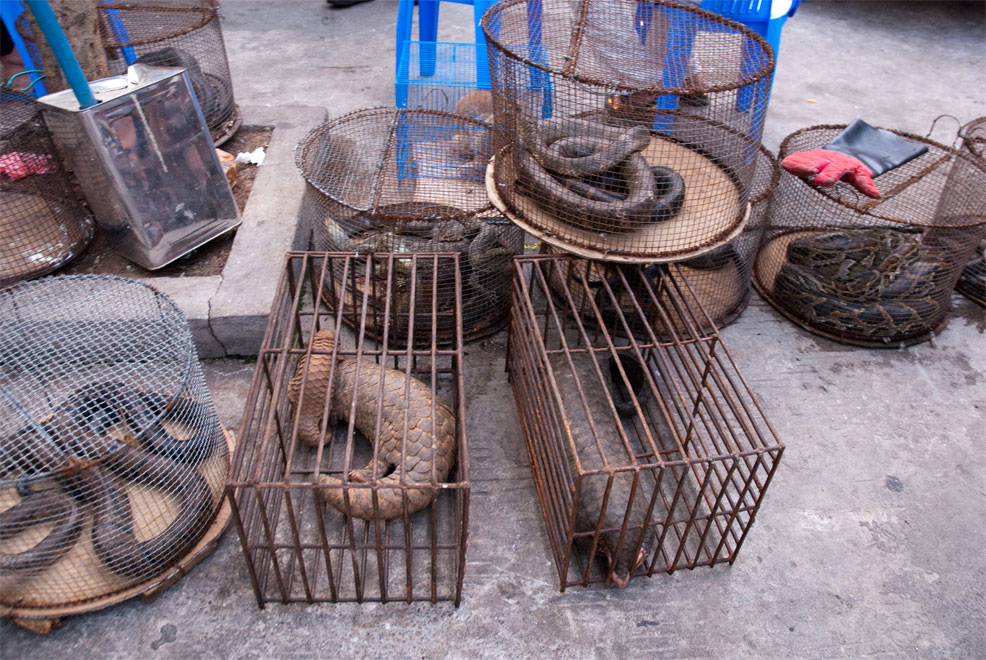
12th May 2022 Future pandemic risks are increasing COVID-19 may prove to be just the first in a series of pandemics throughout the 21st century – unless humans drastically improve their relationship with animals and the natural world.
The first official reports of a new "viral pneumonia" in the Chinese city of Wuhan became public on 31st December 2019. Authorities linked these early cases to people who had visited the Huanan Seafood Wholesale Market, although human-to-human transmission may have begun earlier. Attempts to contain the outbreak in Wuhan failed, allowing it to spread across China and quickly throughout the world. The disease – caused by severe acute respiratory syndrome coronavirus 2 (SARS-CoV-2) – had similarities with SARS-CoV-1, an earlier virus that caused an epidemic from 2002–2004. Unlike the original SARS, however, which infected 8,000 people from 29 countries and resulted in 774 deaths, the SARS-CoV-2 virus would prove to be vastly more dangerous. The World Health Organization (WHO) issued the official name COVID-19 in February 2020 and declared a global pandemic in March 2020. As of May 2022, more than half a billion cases have been reported in almost every country and territory – even in the bases of Antarctica. The official death toll stands at 6.2 million, with an upper estimate as high as 24.3 million, making it one of the deadliest pandemics in human history. For comparison, the Spanish flu of 1918–1920 killed 17 to 100 million, while the bubonic plague of 1346–1353 killed 75–200 million (although the world had a much lower population back then). Some people continue to experience effects (long COVID) for months after recovery, and damage to organs has been observed. Vaccines and other treatments have greatly reduced the severity of COVID-19 – but it remains a problem that society will be dealing with for decades, possibly centuries. While much speculation has been made about an alternative source, the scientific consensus is that SARS-CoV-2 is most likely of zoonotic origin, from bats or another closely related mammal. Experts are now concerned that humanity's ever-increasing impact on the natural world is likely to produce more novel viruses that could be even deadlier and more contagious than SARS-CoV-2. A new study published in Nature highlights the growing risk of cross-species viral transmission. As the global climate continues to warm, researchers predict that wild animals will be forced to relocate their habitats, likely to regions with large human populations. This greatly increases the chances of a viral jump between animals and humans. For their study, the scientists conducted the first comprehensive assessment of how climate and land use change will affect the global mammal-virus network. They focused on geographic range shifts – when and where species will move into new habitats. As they encounter other mammals for the first time, the study projects they will share thousands of viruses. These shifts bring more opportunities for viruses like Ebola or coronaviruses to emerge in new areas, making them harder to track, and into new types of animals, making it easier for viruses to jump across a "stepping stone" species into humans. The study predicts that due to climate and land use change, species will aggregate in new combinations at high elevations, in biodiversity hotspots, and in areas with high human population densities. As many as 4,000 viruses could spread between mammals – including potentially between animals and humans – for the first time by 2070.
In 2070, human population centres will overlap with hotspots of cross-species viral transmission. Credit: Colin Carlson/Georgetown University
"Surprisingly, we find that this ecological transition may already be underway, and holding warming under 2°C will not reduce future viral sharing," the study authors write. "Our findings highlight an urgent need to pair viral surveillance and discovery efforts with biodiversity surveys tracking species' range shifts, especially in tropical regions that harbour the most zoonoses and are experiencing rapid warming." An additional important finding is the impact rising temperatures will have on bats, which account for the majority of novel viral sharing. Their ability to fly will allow them to travel long distances and share the most viruses. Because of their central role in viral emergence, the greatest impacts are projected to occur in southeast Asia, a global hotspot of bat diversity. "At every step, our simulations have taken us by surprise," said Colin Carlson, PhD, an assistant research professor at the Center for Global Health Science and Security at Georgetown University Medical Center. "We've spent years double-checking those results, with different data and different assumptions, but the models always lead us to these conclusions. It's a really stunning example of just how well we can, actually, predict the future if we try." "This is happening. It is not preventable, even in the best-case climate change scenarios, and we need to put measures in place to build health infrastructure to protect animal and human populations," said study co-author Gregory Albery, PhD, a disease ecologist at Georgetown. "This mechanism adds yet another layer to how climate change will threaten both human and animal health. It's unclear exactly how these new viruses might affect the species involved, but it's likely that many of them will translate to new conservation risks and fuel the emergence of novel outbreaks in humans." "The COVID-19 pandemic, and the previous spread of SARS, Ebola, and Zika, show how a virus jumping from animals to humans can have massive effects," said Sam Scheiner, a program director with the U.S. National Science Foundation (NSF), which funded the research. "To predict their jump to humans, we need to know about their spread among other animals. This research shows how animal movements and interactions due to a warming climate might increase the number of viruses jumping between species." "We're closer to predicting and preventing the next pandemic than ever," added Carlson. "This is a big step towards prediction – now we have to start working on the harder half of the problem." Overall, the team's study suggests that climate change will become the biggest risk factor for disease emergence. Other contributing factors will be deforestation, the wildlife trade, and industrial agriculture.
In related news, a lineage of H3N8 bird flu has infected a human for the first time, with a case reported in the Henan province of China. A four-year-old boy developed a fever and other flu symptoms after being in contact with chickens and crows raised at his home last month, according to health authorities. The number of bird flu strains jumping from birds to humans is causing concern. The H5N1 sub-type, first seen in humans in 1997, has since resulted in a total of 863 cases and 455 deaths, a mortality rate of 53%. The H7N9 strain, which first jumped to humans in 2013, has seen 1,622 cases and 619 deaths, a mortality rate of 38%. More and more of these viruses are making the jump – H5N6 in 2014, H9N2 in 2015, H7N4 in 2018, H5N8 and H10N3 in 2021, and now the recent case of H3N8 in 2022. For now, bird flu viruses are unable to spread between humans easily. However, scientists say that H5N1, for example, may be just three mutations away from becoming as transmissible as the common cold or COVID-19. With such high mortality rates for bird flu, the consequences of a worldwide pandemic could be catastrophic for the human population. The UK has recently experienced the biggest outbreak of bird flu ever seen, with over 100 outbreaks of H5N1 in commercial farms from one end of the country to the other. Millions of birds have been culled to stop the spread of disease, but cases continue to be seen, clustering in areas with high-density poultry farming. There are over 26 billion chickens in the world – more than three birds for every person on the planet. Factory farms provide an ideal breeding ground for a mutating virus. UK animal charity Viva has been investigating these farms and exposing the horrific conditions that chickens and pigs are forced to endure during their short lives. "Over one billion chickens are slaughtered for their meat in the UK every year and 95% are intensively reared on factory farms," the nonprofit states. "We are handing viruses the perfect opportunity to mutate into more deadly forms. We need to remove the viral reservoir and end factory farming, before it ends us."
To prevent the spread of new diseases, humanity needs to fundamentally overhaul its relationship with the natural world. That means transitioning away from factory farms by giving animals more space and better conditions. It means eating more plant-based foods to lower demand for meat, dairy, and eggs. Fossil fuels, which propelled us through the Industrial Revolution and created the modern world we enjoy today, are now threatening our very survival and their phase out must be accelerated. Deforestation must be halted and reversed, as proposed at COP26. Another vitally important step to lower pandemic risks will be improved viral surveillance and biodiversity surveys to track species' range shifts in a warming world. Alongside these efforts, science can provide alternatives to breeding and slaughtering animals. Recent developments with cultured ("lab-grown") meat have been remarkable and there is potential for this to become another "exponential" industry – rapidly scaling up to feed billions of people worldwide in combination with novel vegan replacements. The reduction in disease risk can bring the side benefit of eliminating animal welfare concerns, since the meat is simply grown from individual cells. Cultured meat also requires 90% less land and water, which could free up vast areas of Earth's surface for ecological restoration and other uses. In the longer term – perhaps towards the end of this century – we can imagine a world saturated with real-time viral, genetic, environmental, and other data providing a godlike overview of both animal and human health. This flood of global information will be monitored, analysed, and acted on by super-AI, with new vaccines or antivirals being simulated and trialled virtually, at breathtaking speed. By then, traditional meat will be largely or entirely replaced by synthetic or plant-based alternatives. Our energy system will be transformed and fully decarbonised, with a massive industry of carbon-negative technologies. Humans and their animal neighbours could finally live in harmony. That is the future that awaits us – if we want it.
Comments »
If you enjoyed this article, please consider sharing it:
|









